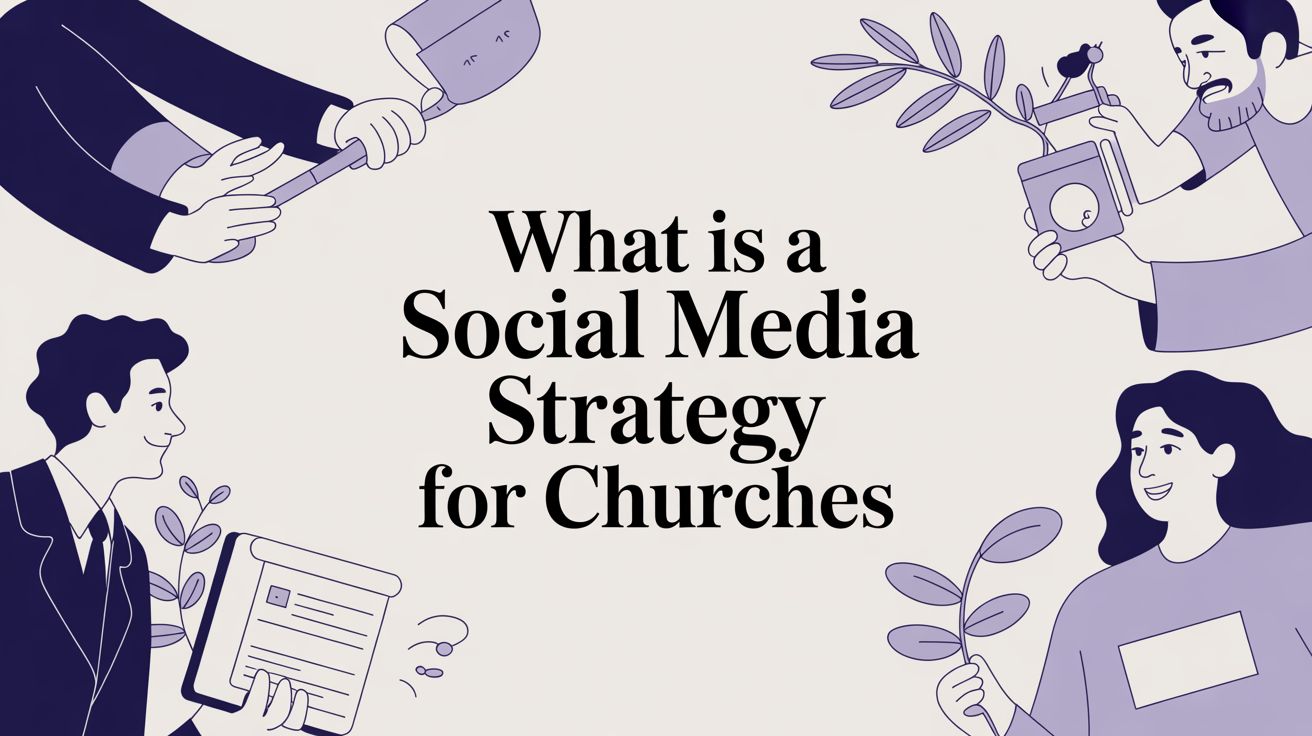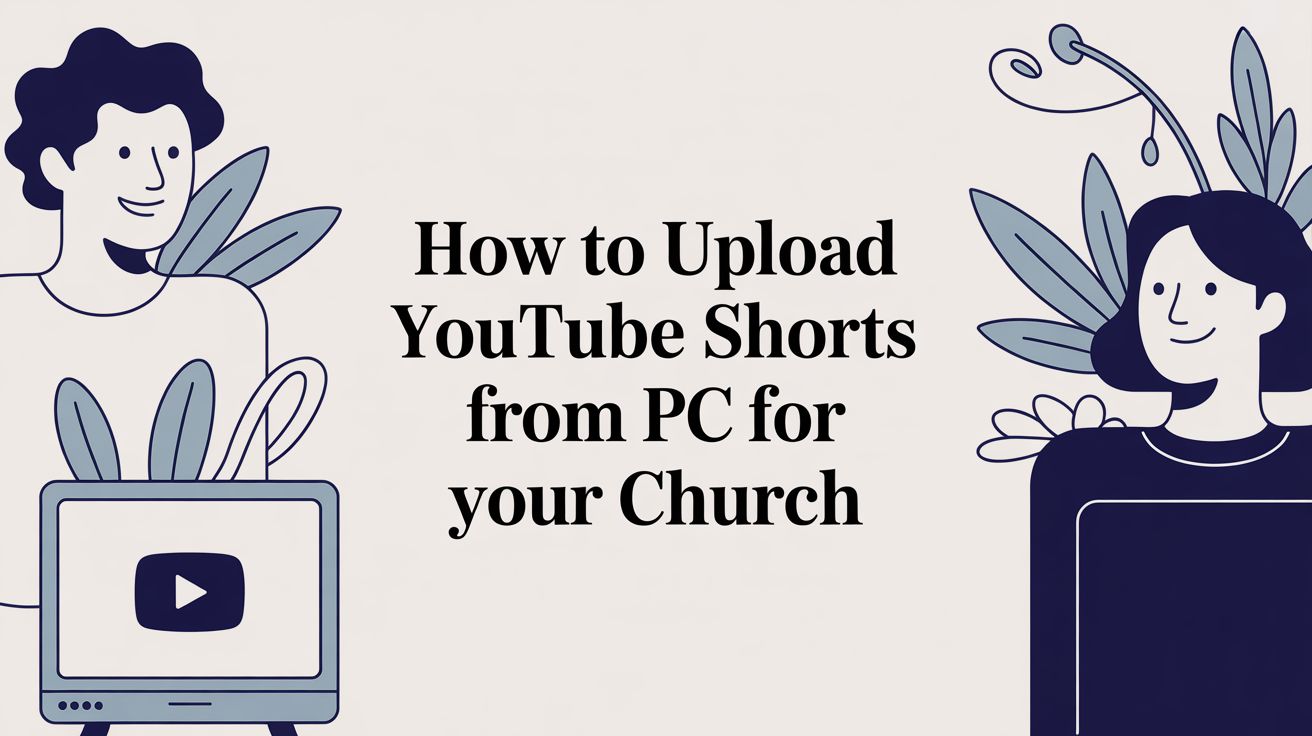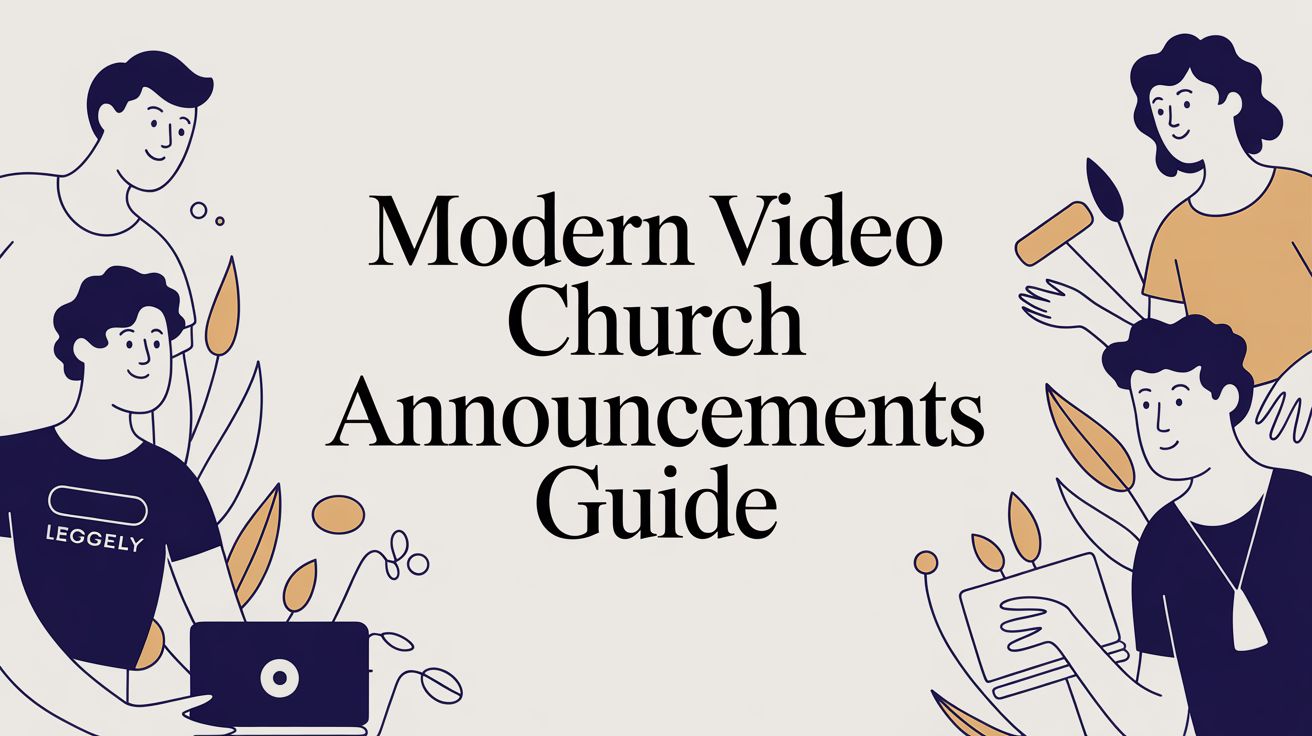So, what exactly is a social media strategy? Think of it less like a to-do list and more like a roadmap for your ministry's digital outreach. It’s the game plan that guides how you’ll share your church's heart, message, and community with the world online. This blueprint turns social media from a weekly chore into a powerful, purposeful ministry tool.
Why Your Church Needs a Social Media Blueprint
Imagine building a house without a blueprint. You might end up with a random collection of rooms that don't quite fit together. A social media strategy is that essential blueprint for your church's digital home. It provides direction, making sure every sermon clip, event graphic, and encouraging post works together to create a welcoming, cohesive online space for both your congregation and your local community.

This planned approach is what moves your church from just being on social media to using it with real intention. The goal is to build a consistent, engaging presence that truly reflects the life and mission of your ministry. When done right, your social media feeds become a genuine extension of your church walls—a place for connection, encouragement, and community all week long.
From Random Posts to Intentional Ministry
A documented strategy keeps your team focused on what actually matters. Instead of scrambling and guessing what to post each day, you have a guide that clarifies your core messages and goals. This is absolutely critical when you consider that the average person spends over 2 hours and 21 minutes scrolling through social media every single day. A solid plan helps you thoughtfully capture a tiny piece of that attention for a much greater purpose.
This is especially true for churches, which often run on the passion of volunteers and staff with limited time. The principles behind social media marketing for small businesses can be incredibly helpful here, offering simple yet powerful ways to connect without a huge budget or team.
To really get this right, it's important to understand the difference between your overarching strategy and the individual tactics you use to execute it.
Strategy vs Tactics in Church Social Media
This table clarifies the difference between your high-level strategy (the 'why') and the specific tactics (the 'how') you use to bring it to life.
Your strategy is the vision, while tactics are the concrete steps you take to make that vision a reality.
Streamlining Your Digital Outreach
The real beauty of a strategy is how it makes your efforts so much more efficient. Instead of constantly fighting to come up with new ideas, your plan gives you a clear path forward.
A great strategy isn't about doing more work; it's about making the work you do more effective. It turns scattered efforts into a focused, impactful digital ministry that saves time and builds community.
This is where a tool built specifically for ministry can make all the difference. With a platform like ChurchSocial.ai, bringing your strategy to life becomes surprisingly simple. You can create AI-generated reels from your sermons, use our graphic templates and editor to create and post photos and carousels, and our simple drag-and-drop calendar allows your church to easily manage and update all of its social media. We also integrate with Planning Center and other church calendars to create content for events, freeing up your team to focus on what matters most: people, not posts.
Building the Foundation of Your Strategy
Every strong ministry is built on a solid foundation, and your social media strategy is no different. But this foundation isn't about chasing complicated marketing theories. It's about getting crystal clear on your church's unique mission and DNA.
Think of it this way: you have to move past vague goals like "getting more followers" and start defining clear, ministry-focused objectives that actually make a difference in people's lives.
Before you can build anything, you have to survey the land. A critical first step is simply listening to the online conversations happening in your community. Understanding the difference between social listening vs monitoring is huge here. It helps you uncover what people are really looking for in a church, the questions they're asking, and the needs they have. This insight will shape your entire plan.
Set Clear Ministry-Focused Objectives
Your social media goals need to be a direct reflection of your church's vision. Instead of chasing vanity metrics, think about specific outcomes that push your mission forward.
- Objective Example 1: Increase sign-ups for our new members' class by 25% this semester using targeted Facebook event promotions.
- Objective Example 2: Drive 500 views to our latest sermon on YouTube each week, extending our message way beyond Sunday morning.
- Objective Example 3: Get 30 new people to register for our upcoming community outreach event by leaning into Instagram Stories.
See the difference? These objectives are specific, measurable, and tied directly to the life of your church. They turn social media from a simple megaphone into a powerful tool for discipleship and growth. With a platform like ChurchSocial.ai, you can actually track the clicks and engagement on these posts, connecting the dots between your online efforts and those real-world ministry wins.
Identify and Understand Your Audience
Who are you actually trying to reach? Let’s be honest, your "audience" isn't one giant, faceless crowd. It’s made up of real people in different life stages with very different needs. A smart strategy speaks to each of them intentionally.
You’re probably talking to a few key groups:
- Current Members: You want to keep them in the loop, informed about what’s happening, and encouraged in their faith all week long.
- Newcomers in the Community: These are the families or singles who just moved to town and are actively looking for a church to call home.
- The Spiritually Curious: This group includes people who might not be ready to walk through your doors on a Sunday, but they’re open to exploring questions of faith online.
Establish Your Content Pillars
Finally, to keep your content focused and purposeful, you need content pillars. Think of these as the main themes or topics you'll consistently talk about. They ensure you’re sharing a well-rounded picture of who you are as a church.
Content pillars act as the structural supports for your digital ministry. They guarantee that your messaging is balanced, consistent, and always points back to your core mission, preventing your feed from becoming random or one-dimensional.
For a church, these pillars might look something like this:
- Worship: Sharing sermon clips, highlights from worship songs, and encouraging scripture.
- Community: Putting the spotlight on volunteers, promoting small groups, and sharing authentic, behind-the-scenes moments.
- Outreach: Announcing community service projects, inviting people to local events, and showing how you're loving your city.
- Discipleship: Posting discussion questions from the latest sermon or sharing resources for spiritual growth.
Once you have these pillars, content creation gets so much simpler. And when you use a tool like ChurchSocial.ai, you can easily generate posts that fit perfectly into each pillar—turning a sermon into a "Worship" reel or an event from your Planning Center calendar into a "Community" graphic. This foundational work is what makes your digital ministry both authentic and sustainable.
Creating Content Your Congregation Will Love
Think of content as the fuel for your entire social media engine. It’s the stuff that actually connects with people, where your plan stops being a document and starts being a conversation. To really build a community online, your church has to go beyond just posting event flyers. We need to create posts that genuinely engage, inspire, and serve the people tuning in.
The goal is to create a rich mix of content that both feeds your existing church family and rolls out the welcome mat for anyone just discovering your ministry online.
A fantastic starting point? Squeezing every last drop of goodness out of each sermon. Your pastor's weekend message is a content goldmine just waiting to be tapped. Imagine turning one sermon into a whole week's worth of shareable, encouraging posts. That’s how you extend the impact of Sunday morning all week long.
From Sermon to Social Media Feed
With a tool like ChurchSocial.ai, repurposing your sermons becomes almost effortless. The AI can actually listen to your sermon audio, pull out the key moments, and then generate a whole buffet of content for you, from social posts to blogs.
- AI-Generated Reels: Instantly create several short, powerful video clips from your sermon that highlight the main points. These are perfect for Instagram and TikTok.
- Quote Graphics: Pull out powerful one-liners and turn them into beautifully designed graphics using our simple templates and editor.
- Discussion Prompts: Spark real conversation in the comments by generating thoughtful questions directly tied to the sermon's themes.
This simple workflow gives you a steady stream of biblically-solid content that reinforces the teaching throughout the week, all without adding hours of extra work for your team.
This diagram shows how a solid strategy provides the foundation for every single piece of content you create.

As you can see, your big-picture goals should flow directly into the kind of content you develop for the specific people you're trying to reach.
Ideas to Inspire Your Congregation
Beyond just sermon clips, a healthy social media feed tells the whole story of your church. It’s less about the schedule and more about the heart.
Try mixing some of these ideas into your content calendar:
- Volunteer Spotlights: Shine a light on the people serving faithfully behind the scenes. A quick photo and a sentence or two about why they love to serve can be so encouraging.
- Behind-the-Scenes Glimpses: Show the worship team rehearsing or the kids' ministry team prepping for Sunday. These moments make your church feel real and human.
- Interactive Polls: Ask fun, simple questions in your stories. Think "Favorite worship song right now?" or "Coffee or donuts after service?"
Creating content your congregation loves isn't about being flashy; it's about being faithful to share the real, everyday life of your church community. It’s about connection over perfection.
With ChurchSocial.ai, you can lean on our graphic templates and simple editor to create and post beautiful photos and carousels for these posts. From there, it's a breeze to schedule everything on our simple drag-and-drop calendar, ensuring you have a consistent and loving presence online.
How to Plan and Schedule Your Content
Consistency. It’s the secret sauce for building any kind of momentum online, but for a busy church staff, it’s usually the first thing to go. This is exactly why a real plan for scheduling your content isn't just a "nice-to-have"—it's an absolute ministry essential.
Enter the content calendar. This is your command center for digital outreach. Think of it less as a rigid schedule and more as a blueprint for your communication, helping you map everything from sermon series and special events to weekly themes and daily bits of encouragement. The goal isn't just to fill slots; it's to create a sane, sustainable workflow that actually saves you time and cuts down on the last-minute panic.

When you plan ahead, you can start batching your work. Imagine dedicating just a few hours to create and schedule an entire week's worth of posts instead of scrambling every single morning. It also gives you a bird's-eye view of your messaging, so you don't accidentally post about the youth bake sale three times while completely forgetting to mention small group sign-ups.
If you want to dive deeper, we have a whole guide on building an effective social media content calendar for your church.
Streamlining Your Workflow
The trick to a successful content calendar is making it genuinely easy to manage. Let's be honest, juggling spreadsheets and multiple platform logins is a recipe for burnout. This is where a unified platform completely changes the game for your ministry.
A well-managed content calendar doesn't just organize your posts; it organizes your peace of mind. It transforms social media from a source of constant pressure into a predictable, manageable, and joyful part of your ministry.
Tools like ChurchSocial.ai were designed to solve this exact problem for churches. Our simple drag-and-drop calendar allows churches to easily manage and update all of their social media. You can easily shuffle posts around, reschedule content, and make sure you have a healthy mix from your content pillars—all without leaving the platform. That centralized view is the key to telling a cohesive story online.
Automating Your Church Calendar Events
One of the biggest time-sucks for any church communicator is manually creating posts for every single church event. With ChurchSocial.ai, you can connect your existing church calendars, like Planning Center, directly to your social media schedule.
This integration is a massive time-saver. When you add a new event to Planning Center, ChurchSocial.ai can automatically:
- Pull all the event details: It grabs the name, date, time, and description for you.
- Create content for events: It can generate timely posts leading up to the event so you don't have to.
- Use branded templates: You can use our graphic templates to create beautiful, on-brand announcements in just a couple of clicks.
This frees up your team from hours of mind-numbing copy-pasting and design work. Instead of getting bogged down in repetitive admin tasks, you can focus on what actually matters: crafting a message that connects with people and engaging with your community in a meaningful way.
Using AI to Amplify Your Church's Message
Let's be honest, the idea of using artificial intelligence in ministry can feel a bit… off. It sounds technical, maybe even a little impersonal. But what if we thought about it differently? What if technology wasn't about replacing personal connection, but about creating more space for it?
The real gift of AI for your church is time. Think of it as the ultimate ministry assistant—one that never gets tired. It’s a tool that handles the repetitive, time-consuming digital tasks, freeing you and your volunteers to focus on what you do best: shepherding people. It levels the playing field, giving any ministry the chance to have a powerful online voice without needing a huge budget or a dedicated media team.
How Does This Actually Work for a Church?
So, what does this look like day-to-day? A smart social media strategy doesn't just mean posting more; it means using the right tools to work smarter. And the pros are already on board—research predicts that by 2025, more than 75% of top-level social media strategists will be using AI to help guide their work. This isn't just about creating content; it's about making your entire ministry outreach more effective. You can see the data for yourself in Hootsuite's research on social trends.
A platform like ChurchSocial.ai takes this powerful technology and makes it genuinely simple and accessible for your ministry. It’s not a generic business tool; it's built specifically for the unique needs of a church.
Here are a few practical ways it helps:
- Create Reels from Sermons: Simply upload your sermon audio. The AI automatically finds the most powerful, shareable moments and turns them into multiple, engaging AI-generated reels. One sermon suddenly becomes a week's worth of impactful content.
- Create Content from Transcripts: The AI can also take that same sermon transcript and generate a variety of AI-generated content like social posts, blogs, and even small group discussion questions.
- Generate New Content Ideas: Feeling stuck in a creative rut? The AI can suggest fresh post ideas that align perfectly with your content pillars, making sure you always have something relevant to share with your community.
More Time for What Truly Matters
The real win here is efficiency. Instead of spending hours wrestling with video editing software or staring at a blank screen trying to write a caption, you can get it all done in minutes. For pastors and ministry volunteers who are already wearing multiple hats, that's a game-changer. You can learn more in our guide on how AI can specifically benefit churches.
Technology should serve the mission, not become the mission. By automating the routine digital work, AI gives you the margin to have more conversations, build deeper relationships, and invest in your community—both online and in person.
To make things even easier, ChurchSocial.ai integrates with calendars you already use, like Planning Center. This means it can automatically create content for your upcoming events, saving you even more time. With our graphic templates and editor, you can create and post professional photos and carousels, then schedule everything on our simple drag-and-drop calendar. It’s all about making a high-quality, consistent online ministry achievable for every single church.
Measuring What Matters for Your Ministry
So, how can you tell if all this effort on social media is actually making a difference for your church? It’s a fair question. The answer isn't found in counting likes or followers. For a church, success looks different. It’s about connection. It's about community. It’s about real-world impact.
It’s time to look past the "vanity metrics" and zero in on what truly matters.
This means we need to shift our thinking from passive numbers to active engagement—the kind of engagement that shows a community is actually forming. Real success is seeing a flood of heartfelt comments on a prayer request post. It's watching the clicks roll in from an Instagram story that links to your "Plan a Visit" page. It’s seeing new families sign up for VBS after they saw a post about it on Facebook. Those are the numbers that count.
Tracking True Ministry Growth
Think of your social media analytics as a form of spiritual feedback. These numbers aren't about performance; they're about stewardship. They give you a window into what content truly connects with your congregation and what piques the interest of someone looking for a church home.
For a church, the ultimate goal of a social media strategy isn’t just to be seen online, but to see lives changed offline. Measurement is simply the tool that helps you ensure your digital efforts are making a tangible, real-world impact on your ministry.
By reviewing these insights, you can fine-tune your approach over time to serve your people better.
A simple monthly or quarterly check-in can help you learn and adapt. For instance, did a sermon reel about forgiveness get way more shares than usual? That's a huge clue to create more content around that theme. Did your event post lead to crickets and zero sign-ups? That’s not a failure; it’s a great opportunity to rethink how you promote events.
This kind of informed approach makes sure your time online is directly fueling your church's mission. To help you dive deeper, we have a complete guide that simplifies how to measure social media ROI for your church in a way that makes sense for ministry.
Platforms like ChurchSocial.ai are designed for this very purpose. We give you clear, easy-to-read analytics built for pastors and church staff, not marketing gurus. You can instantly see which posts are inspiring people to take the next step, helping you draw a straight line from your digital strategy to tangible spiritual growth.
Common Questions About Church Social Media
Running social media for a church can feel like a whole separate job, and it often brings up some tricky questions. Let's tackle a few of the most common ones I hear from ministry leaders.
How Much Time Should We Spend on Social Media Each Week?
Believe it or not, you can make a real impact in just 3-5 hours per week. The trick isn't to be online 24/7, but to work smart.
With a clear strategy and a tool like ChurchSocial.ai that's built for ministry, you can slash the time it takes to create and schedule your content. It’s all about consistent, planned effort, not getting sucked into a constant cycle of reactive posting.
Which Social Media Platforms Are Best for Our Church?
When you're starting out, focus is your friend. For most churches, Facebook and Instagram are the best places to be.
Facebook is fantastic for building that deep sense of community and getting the word out about events. Instagram, on the other hand, is perfect for connecting with a younger demographic through visually compelling sermon clips, inspirational graphics, and behind-the-scenes moments. It's far better to master one or two platforms than to spread yourself too thin across all of them.
What if Our Church Has No Social Media Budget?
That’s perfectly fine. A powerful social media ministry doesn't need a huge budget to thrive. In fact, some of your most powerful content—a heartfelt testimony from a member, a quick video from a service project—costs absolutely nothing to capture.
An effective social media strategy is built on authenticity and connection, not expensive tools. Your ministry’s heart is your greatest asset.
This is also where affordable, all-in-one tools can make a massive difference. A platform like ChurchSocial.ai bundles everything you need (design, scheduling, and AI writing help) into one package, giving you a professional-level strategy that fits any church's budget.
Ready to turn your social media plan into a vibrant digital ministry? With ChurchSocial.ai, you get tools designed specifically for churches to help you save time, create beautiful content, and share your message further than ever before.
Start simplifying your church's social media today at https://churchsocial.ai



